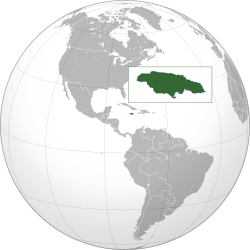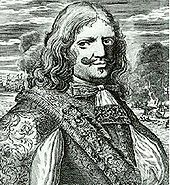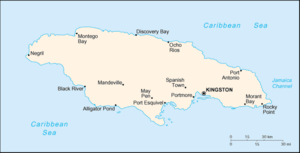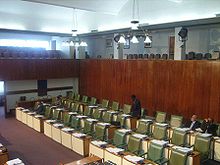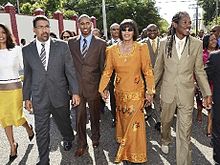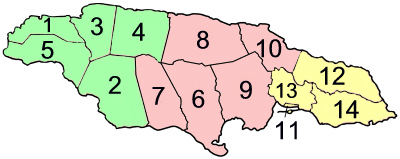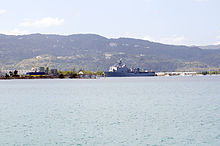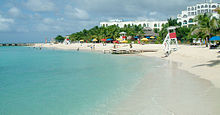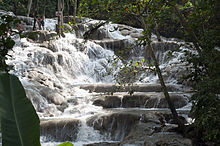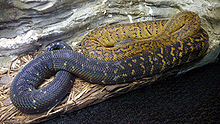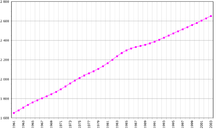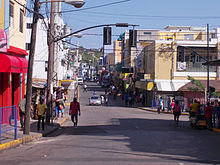
Jamaica
Background Information
This selection is made for schools by a children's charity read more. To compare sponsorship charities this is the best sponsorship link.
Coordinates: 18°10′57″N 77°19′18″W
| Jamaica | ||||||
|---|---|---|---|---|---|---|
|
||||||
| Motto: "Out of Many, One People" | ||||||
Anthem:
|
||||||
|
|
||||||
| Capital and largest city |
Kingston 17°59′N 76°48′W |
|||||
| Official languages |
|
|||||
| National language | Jamaican Patois ( de facto) | |||||
| Demonym | Jamaican | |||||
| Government | Parliamentary democracy under constitutional monarchy | |||||
| - | Monarch | Elizabeth II | ||||
| - | Governor-General | Patrick Allen | ||||
| - | Prime Minister | Portia Simpson-Miller | ||||
| Legislature | Parliament | |||||
| - | Upper house | Senate | ||||
| - | Lower house | House of Representatives | ||||
| Independence | ||||||
| - | from the United Kingdom | 6 August 1962 | ||||
| Area | ||||||
| - | Total | 10,991 km2 ( 166th) 4,244 sq mi |
||||
| - | Water (%) | 1.5 | ||||
| Population | ||||||
| - | July 2012 estimate | 2,889,187 ( 139th) | ||||
| - | Density | 252/km2 ( 49th) 656/sq mi |
||||
| GDP ( PPP) | 2011 estimate | |||||
| - | Total | $24.750 billion | ||||
| - | Per capita | $9,029 | ||||
| GDP (nominal) | 2011 estimate | |||||
| - | Total | $14.807 billion | ||||
| - | Per capita | $5,402 | ||||
| Gini (2004) | 45.5 medium |
|||||
| HDI (2012) | high · 80th |
|||||
| Currency | Jamaican dollar ( JMD) |
|||||
| Time zone | ( UTC-5) | |||||
| Drives on the | left | |||||
| Calling code | +1-876 | |||||
| ISO 3166 code | JM | |||||
| Internet TLD | .jm | |||||
Jamaica ( / dʒ ə ˈ m eɪ k ə /) is an island country situated in the Caribbean Sea, comprising the third-largest island of the Greater Antilles. The island, 10,990 square kilometres (4,240 sq mi) in area, lies about 145 kilometres (90 mi) south of Cuba, and 191 kilometres (119 mi) west of Hispaniola, the island containing the nation-states of Haiti and the Dominican Republic. Jamaica is the fifth-largest island country in the Caribbean. The indigenous people, the Taíno, called it Xaymaca in Arawakan. meaning the "Land of Wood and Water" or the "Land of Springs".
Once a Spanish possession known as Santiago, in 1655 it came under the rule of England (later Great Britain), and was called Jamaica. It achieved full independence from the United Kingdom on 6 August 1962. With 2.8 million people, it is the third most populous Anglophone country in the Americas, after the United States and Canada. Kingston is the country's largest city and its capital, with a population of 937,700. Jamaica has a large diaspora around the world, due to emigration from the country.
Jamaica is a Commonwealth realm with Elizabeth II as Queen of Jamaica and head of state. Her appointed representative in the country is the Governor-General of Jamaica, currently Sir Patrick Allen. The head of government and Prime Minister of Jamaica is Portia Simpson-Miller. Jamaica is a parliamentary constitutional monarchy with legislative power vested in the bicameral Parliament of Jamaica, consisting of an appointed Senate and a directly elected House of Representatives.
History
Prehistory
The Arawak and Taino indigenous people, originating in South America, settled on the island between 4000 and 1000 BC. When Christopher Columbus arrived in 1494, there were more than 200 villages ruled by caciques (chiefs of villages). The south coast of Jamaica was the most populated, especially around the area now known as Old Harbour. The Taino still inhabited Jamaica when the English took control of the island in 1655. The Jamaican National Heritage Trust is attempting to locate and document any evidence of the Taino/ Arawaks.
Spanish rule
Christopher Columbus claimed Jamaica for Spain after landing there in 1494 and his probable landing point was Dry Harbour, now called Discovery Bay. There is some debate as to whether he landed in St. Ann's Bay or in Discovery Bay. St. Ann's Bay was named "Saint Gloria" by Columbus, as the first sighting of the land. One mile west of St. Ann's Bay is the site of the first Spanish settlement on the island, Sevilla, which was established in 1509 and abandoned around 1524 because it was deemed unhealthy. The capital was moved to Spanish Town, then called St. Jago de la Vega, around 1534 (at present-day St. Catherine).
British rule
Spanish Town has the oldest cathedral of the British colonies in the Caribbean. The Spanish were forcibly evicted by the English at Ocho Rios in St. Ann. In 1655 the English, led by Sir William Penn and General Robert Venables, took over the last Spanish fort in Jamaica. The name of Montego Bay, the capital of the parish of St. James, was derived from the Spanish name manteca bahía (or Bay of Lard), alluding to the lard-making industry based on processing the numerous boars in the area.
In 1660, the population of Jamaica was about 4,500 whites and 1,500 blacks, but by as early as the 1670s, blacks formed a majority of the population.
In 1394, France prohibited Jews as residents. By 1660, Jamaica had become a refuge for Jews in the New World, also attracting those who had been expelled from Spain and Portugal. A settlement of Jews had arrived in 1510, soon after the son of Christopher Columbus settled on the island. Primarily merchants and traders, the Jewish community was forced to live a clandestine life, calling themselves "Portugals". After the British took over rule of Jamaica, the Jews decided the best defense against Spain's regaining control was to encourage making the colony a base for Caribbean pirates. With the pirates installed in Port Royal, the Spanish would be deterred from attacking. The British leaders agreed with the viability of this strategy to forestall outside aggression.
When the English captured Jamaica in 1655, the Spanish colonists fled after freeing their slaves. The slaves dispersed into the mountains, joining the maroons, those who had previously escaped from the Spanish to live with the Taínos. The Jamaican Maroons fought the British during the 18th century. The name is still used today for their modern descendants. During the long centuries of slavery, Maroons established free communities in the mountainous interior of Jamaica, where they maintained their freedom and independence for generations.
During its first 200 years of British rule, Jamaica became one of the world's leading sugar-exporting, slave-dependent nations, producing more than 77,000 tons of sugar annually between 1820 and 1824. After the abolition of the slave trade in 1807, the British imported Indian and Chinese workers as indentured servants to supplement the labour pool. Many of their descendants continue to reside in Jamaica today.
By the beginning of the 19th century, Jamaica's dependence on slave labour and a plantation economy had resulted in blacks outnumbering whites by a ratio of almost 20 to 1. Although the UK had outlawed the importation of slaves, some were still smuggled into the colonies. While planning the abolition of slavery, the British Parliament passed laws to improve conditions for slaves. They banned the use of whips in the field and flogging of women; informed planters that slaves were to be allowed religious instruction, and required a free day during each week when slaves could sell their produce, prohibiting Sunday markets to enable slaves to attend church.
The House of Assembly in Jamaica resented and resisted the new laws. Members (then restricted to European-Jamaicans) claimed that the slaves were content and objected to Parliament's interference in island affairs. Slave owners feared possible revolts if conditions were lightened. Following a series of rebellions on the island and changing attitudes in Great Britain, the British government formally abolished slavery by an 1833 act, beginning in 1834, with full emancipation from chattel slavery declared in 1838. The population in 1834 was 371,070, of whom 15,000 were white, 5,000 free black; 40,000 ‘coloured’ or mixed race; and 311,070 slaves.
Botanical Gardens
In the 19th century, the British established a number of botanical gardens. These included the Castleton Botanical Garden, developed in 1862 to replace the Bath Garden (created in 1779) which was subject to flooding. Bath Garden was the site for planting breadfruit, brought to Jamaica from the Pacific by Captain William Bligh. It became a staple in island diets. Other gardens were the Cinchona Plantation, founded in 1868, and the Hope Garden founded in 1874. In 1872, Kingston was designated as the island's capital.
Supreme Court
In 1945, Sir Horace Hector Hearne became Chief Justice and Keeper of the Records in Jamaica. He headed the Supreme Court, Kingston between 1945 and 1950/1951. He moved to Kenya, which had achieved independence, where he was appointed Chief Justice.
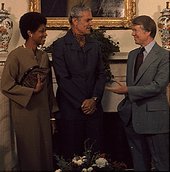
Independence
Jamaica slowly gained increasing independence from the United Kingdom. In 1958, it became a province in the Federation of the West Indies, a federation among the British West Indies. Jamaica attained full independence by leaving the federation in 1962.
Strong economic growth, averaging approximately 6% per annum, marked the first ten years of independence under conservative governments; they were led successively by Prime Ministers Alexander Bustamante, Donald Sangster and Hugh Shearer. The growth was fuelled by strong private investments in bauxite/alumina, tourism, manufacturing industry and, to a lesser extent, the agricultural sector.
The optimism of the first decade was accompanied by a growing sense of inequality, and concern that the benefits of growth were not being shared by the urban poor. Combined with the effects of a slowdown in the global economy in 1970, the electorate was moved to change government, electing the PNP ( People's National Party) in 1972. Despite efforts to create more socially equitable policies in education and health, Jamaica continued to lag economically. By 1980, its gross national product had declined to some 25% below the 1972 level. Due to rising foreign and local debt, accompanied by large fiscal deficits, the government sought International Monetary Fund (IMF) financing from the United States and others. The international bankers imposed IMF austerity measures (with a greater than 25% interest rate per year).
Economic deterioration continued into the mid-1980s, exacerbated by a number of factors; the first and third largest alumina producers, Alpart and Alcoa, closed, and there was a significant reduction in production by the second largest producer, Alcan. In addition, tourism decreased and Reynolds Jamaica Mines, Ltd. left the Jamaican industry.
Government and politics
Jamaica is a parliamentary democracy and constitutional monarchy, with Queen Elizabeth II serving as the Jamaican monarch. However, as Elizabeth II is shared as head of state of fifteen other countries and resides mostly in the United Kingdom, she is thus often represented as Queen of Jamaica in Jamaica and abroad by the Governor-General of Jamaica. The governor-general is nominated by the Prime Minister of Jamaica and the entire Cabinet and appointed by the monarch. All the members of the Cabinet are appointed by the governor-general on the advice of the prime minister. The monarch and the governor-general serve largely ceremonial roles, apart from their reserve powers for use in certain constitutional crisis situations.
Jamaica's current constitution was drafted in 1962 by a bipartisan joint committee of the Jamaican legislature. It came into force with the Jamaica Independence Act, 1962 of the United Kingdom parliament, which gave Jamaica independence.
The Parliament of Jamaica is bicameral, consisting of the House of Representatives (Lower House) and the Senate (Upper House). Members of the House (known as Members of Parliament or MPs) are directly elected, and the member of the House of Representatives who, in the governor-general's best judgement, is best able to command the confidence of a majority of the members of that House, is appointed by the governor-general to be the prime minister. Senators are nominated jointly by the prime minister and the parliamentary Leader of the Opposition and are then appointed by the governor-general.
The current Prime Minister of Jamaica is Portia Simpson-Miller having been inaugurated on 5 January 2012. Prime Minister Simpson-Miller acts as the head of government of Jamaica.
Jamaica has traditionally had a two-party system, with power often alternating between the People's National Party and Jamaica Labour Party (JLP). The party with current administrative and legislative power is the People's National Party, with a two-thirds Parliamentary majority as of 2012.
Parishes
Jamaica is divided into 14 parishes, which are grouped into three historic counties that have no administrative relevance.
| Cornwall County | Capital | km2 | Middlesex County | Capital | km2 | Surrey County | Capital | km2 | |||
| 1 | Hanover | Lucea | 450 | 6 | Clarendon | May Pen | 1,196 | 11 | Kingston | Kingston | 25 |
| 2 | Saint Elizabeth | Black River | 1,212 | 7 | Manchester | Mandeville | 830 | 12 | Portland | Port Antonio | 814 |
| 3 | Saint James | Montego Bay | 595 | 8 | Saint Ann | St. Ann's Bay | 1,213 | 13 | Saint Andrew | Half Way Tree | 453 |
| 4 | Trelawny | Falmouth | 875 | 9 | Saint Catherine | Spanish Town | 1,192 | 14 | Saint Thomas | Morant Bay | 743 |
| 5 | Westmoreland | Savanna-la-Mar | 807 | 10 | Saint Mary | Port Maria | 611 | ||||
Military
The Jamaica Defence Force (JDF) is the small but professional military force of Jamaica. The JDF is based on the British military model with organisation, training, weapons and traditions closely aligned with Commonwealth realms. Once chosen, officer candidates are sent to one of several British or Canadian basic officer courses depending on which arm of service they are selected for. Enlisted soldiers are given basic training at JDF Training Depot, Newcastle or Up Park Camp, both in St. Andrew. As with the British model, NCOs are given several levels of professional training as they rise up the ranks. Additional military schools are available for speciality training in Canada, the United States and the United Kingdom.
The JDF is directly descended from the British West India Regiment formed during the colonial era. The West India Regiment was used extensively by the British Empire in policing the empire from 1795 to 1926. Other units in the JDF heritage include the early colonial Jamaica Militia, the Kingston Infantry Volunteers of WWI and reorganised into the Jamaican Infantry Volunteers in World War II. The West Indies Regiment was reformed in 1958 as part of the West Indies Federation, after dissolution of the Federation the JDF was established.
The Jamaica Defence Force (JDF) comprises an infantry Regiment and Reserve Corps, an Air Wing, a Coast Guard fleet and a supporting Engineering Unit. The infantry regiment contains the 1st, 2nd and 3rd (National Reserve) battalions. The JDF Air Wing is divided into three flight units, a training unit, a support unit and the JDF Air Wing (National Reserve). The Coast Guard is divided between seagoing crews and support crews who conduct maritime safety and maritime law enforcement as well as defence-related operations. The role of the support battalion is to provide support to boost numbers in combat and issue competency training in order to allow for the readiness of the force. The 1st Engineer Regiment was formed due to an increased demand for military engineers and their role is to provide engineering services whenever and wherever they are needed. The Headquarters JDF contains the JDF Commander, Command Staff as well as Intelligence, Judge Advocate office, Administrative and Procurement sections.
In recent years the JDF has been called on to assist the nation's police, the Jamaica Constabulary Force (JCF), in fighting drug smuggling and a rising crime rate which includes one of the highest murder rates in the world. JDF units actively conduct armed patrols with the JCF in high-crime areas and known gang neighbourhoods. There has been vocal controversy as well as support of this JDF role. In early 2005, an Opposition leader, Edward Seaga, called for the merger of the JDF and JCF. This has not garnered support in either organisation nor among the majority of citizens.
Geography and environment
Jamaica is the third largest island in the Caribbean. It lies between latitudes 17° and 19°N, and longitudes 76° and 79°W. Mountains, including the Blue Mountains, dominate the inland. They are surrounded by a narrow coastal plain. Chief towns and cities include the capital Kingston on the south shore, Portmore, Spanish Town, Mandeville, Ocho Ríos, Port Antonio, Negril, and Montego Bay on the north shore.
Kingston Harbour is the seventh-largest natural harbour in the world., which contributed to the city being designated as the capital in 1872.
Tourist attractions include Dunn's River Falls in St. Ann, YS Falls in St. Elizabeth, the Blue Lagoon in Portland. Port Royal was the site of a major earthquake in 1692 that helped form the island's Palisadoes.
The climate in Jamaica is tropical, with hot and humid weather, although higher inland regions are more temperate. Some regions on the south coast, such as the Liguanea Plain and the Pedro Plains, are relatively dry rain-shadow areas.
Jamaica lies in the hurricane belt of the Atlantic Ocean and because of this, the island sometimes suffers significant storm damage. Hurricanes Charlie and Gilbert hit Jamaica directly in 1951 and 1988, respectively, causing major damage and many deaths. In the 2000s (decade), hurricanes Ivan, Dean, and Gustav also brought severe weather to the island.
Among the variety of terrestrial, aquatic and marine ecosystems are dry and wet limestone forests, rainforest, riparian woodland, wetlands, caves, rivers, seagrass beds and coral reefs. The authorities have recognized the tremendous significance and potential of the environment and have designated some of the more 'fertile' areas as 'protected'. Among the island's protected areas are the Cockpit Country, Hellshire Hills, and Litchfield forest reserves. In 1992, Jamaica's first marine park, covering nearly 6 square miles (about 15 km2), was established in Montego Bay. Portland Bight Protected Area was designated in 1999.
The following year Blue and John Crow Mountains National Park was created on roughly 300 square miles (780 km2) of wilderness, which supports thousands of tree and fern species and rare animals.
Flora and fauna
Jamaica's climate is tropical, supporting diverse ecosystems with a wealth of plants and animals.
Jamaica's plant life has changed considerably over the centuries. When the Spanish arrived in 1494, except for small agricultural clearings, the country was deeply forested. The European settlers cut down the great timber trees for building and ships' supplies, and cleared the plains, savannas, and mountain slopes for intense agricultural cultivation. Many new plants were introduced including sugarcane, bananas, and citrus trees.
Areas of heavy rainfall contain stands of bamboo, ferns, ebony, mahogany, and rosewood. Cactus and similar dry-area plants are found along the south and southwest coastal area. Parts of the west and southwest consist of large grasslands, with scattered stands of trees.
The Jamaican animal life, typical of the Caribbean, includes highly diversified wildlife with many endemic species found nowhere else on earth. As with other oceanic islands, land mammals are mostly Bats. The only non-bat native mammal extant in Jamaica is the Jamaican Hutia, locally known as the coney. Introduced mammals such as Wild Boar and the Small Asian Mongoose are also common. Jamaica is also home to about 50 species of reptiles, the largest of which is the American Crocodile; however, it is only present within the Black River and a few other areas. Lizards such as Anoles, Iguanas and snakes such as racers and the Jamaican Boa (the largest snake on the island), are common in areas such as the Cockpit Country. None of Jamaica's eight species of native snakes is venomous. One species of freshwater turtle is native to Jamaica, the Jamaican Slider. It is found only on Jamaica, Cat Island, and a few other islands in The Bahamas. In addition, many types of frogs are common on the island, especially Treefrogs. Birds are abundant, and make up the bulk of the endemic and native vertebrate species. Beautiful and exotic birds, such as the Jamaican Tody and the Doctor Bird (the national bird), can be found among a large number of others.
Jamaican waters contain considerable resources of fresh-and saltwater fish. The chief varieties of saltwater fish are Kingfish, Jack, Mackerel, Whiting, Bonito, and Tuna. Fish that occasionally enter freshwater and estuarine environments include Snook, Jewfish, Mangrove snapper, and Mullets. Fish that spend the majority of their lives in Jamaica's fresh waters include many species of Livebearers, Killifish, freshwater Gobies, the Mountain Mullet, and the American Eel. Tilapia have been introduced from Africa for aquaculture, and are very common.
Insects and other invertebrates are abundant, including the world's largest centipede, the Amazonian Giant Centipede, and the Homerus Swallowtail, the Western Hemisphere's largest butterfly.
Demographics
Ethnic origins
According to the 2001 census, the majority of Jamaica's population is of African descent (referring to those who identify as having origins mainly in Africa). The most common ethnic groups among all Africans taken to Jamaica were the Akan (known as the " Coromantee") from present-day Ghana and the Igbo from present-day Nigeria.
Multiracial Jamaicans form the second largest racial group, many of whom also have Irish ancestry. Most mixed-race people on the island self-report simply as "Jamaican".
76.3% African descent, 15.1% Afro-European, 3.4% East Indian and Afro-East Indian, 3.2% Caucasian, 1.2% Chinese and 0.8% Other.
Jamaicans of African descent form 76.3% of the population and are the majority. Indian form 3.4% Chinese ancestry form 1.2%, and other ethnic groups make 0.8%. the next largest racial group after multiracial Jamaicans. Lebanese, Syrian, English, Scottish, Irish, and German Jamaicans make up a smaller racial minority but are still influential both socially and economically.
In recent years, immigration has increased, coming mainly from China, Haiti, Cuba, Colombia, and Latin American countries; 20,000 Latin Americans reside in Jamaica. About 7,000 Americans also reside in Jamaica, as well as many first-generation American, British and Canadians of Jamaican descent.
Language
The official language of Jamaica is English. Jamaicans primarily speak an English-African Creole language known as Jamaican Patois, which has become known widely through the spread of Reggae music. Jamaican Patois was formed from a base of mainly English words with elements of re-formed grammar, together with a little vocabulary from African languages and Native American words. Some archaic features are reminiscent of Irish English.
Emigration
Many Jamaicans have emigrated to other countries, especially to the United Kingdom, the United States, and Canada. In the case of the United States, about 20,000 Jamaicans per year are granted permanent residence. The great number of Jamaicans living abroad has become known as the Jamaican diaspora. There has also been emigration of Jamaicans to Cuba. The scale of emigration has been widespread and similar to other Caribbean entities such as Puerto Rico, Guyana, and The Bahamas. It is estimated that up to 2.5 million Jamaicans and Jamaican descendants live abroad. An estimated 60% of the highly educated people of Jamaica now live abroad.
Concentrations of expatriate Jamaicans are quite considerable in numerous cities in the United States, including New York City, Buffalo, the Miami metro area, Atlanta, Chicago, Orlando, Tampa, Washington, D.C., Philadelphia, Hartford, Providence and Los Angeles. Jamaicans in the United Kingdom number an estimated 800,000 making them by far the country's largest African-Caribbean group. Large-scale migration from Jamaica to the UK occurred primarily in the 1950s and 1960s (when the country was still under British rule). Jamaican communities exist in most large UK cities. In Canada, the Jamaican population is centred in Toronto, and there are smaller communities in cities such as Hamilton, Montreal, Vancouver and Ottawa.
Crime
Jamaica has had one of the highest murder rates in the world for many years, according to UN estimates. Some areas of Jamaica, particularly cities such as Kingston, experience high levels of crime and violence. Many Jamaicans are hostile toward LGBT and intersex people. Various mob attacks against gay people have been reported, prompting human-rights groups to call Jamaica "the most homophobic place on earth."
Religion
Christianity is the largest religion practised in Jamaica and according to the 2001 census, the country's largest denominations are the Church of God of Prophecy (24% of the population), Seventh-day Adventist Church (11%), Pentecostal (10%), Baptist (7%), Anglican (4%), Roman Catholic (2%), United Church (2%), Methodist (2%), Moravian (1%) and Plymouth Brethren (1%) The Christian faith gained acceptance as British Christian abolitionists and Baptist missionaries joined educated former slaves in the struggle against slavery.
The Rastafari movement had 24,000 adherents, according to the 2001 census. Other religions in Jamaica include Jehovah's Witnesses (2% population), the Bahá'í faith, which counts perhaps 8,000 adherents and 21 Local Spiritual Assemblies, Buddhism, and Hinduism. There is a small population of Jews, about 200, who describe themselves as Liberal-Conservative. The first Jews in Jamaica trace their roots back to early 15th century Spain and Portugal. Other small groups include Muslims, who claim 5,000 adherents, as do the Mormons.
Culture

Though a small nation, Jamaican culture has a strong global presence. The musical genres reggae, ska, mento, rocksteady, dub, and, more recently, dancehall and ragga all originated in the island's vibrant, popular urban recording industry. Jamaica also played an important role in the development of punk rock, through reggae and ska. Reggae has also influenced American rap music, as they share roots as rhythmic, African styles of music. Some rappers, such as The Notorious B.I.G. and Heavy D, are of Jamaican descent. Internationally known reggae musician Bob Marley was also Jamaican.
Many other internationally known artists were born in Jamaica, including Millie Small, Lee "Scratch" Perry, Peter Tosh, Bunny Wailer, Big Youth, Jimmy Cliff, Dennis Brown, Desmond Dekker, Beres Hammond, Beenie Man, Shaggy, Grace Jones, Shabba Ranks, Super Cat, Buju Banton, Sean Paul, I Wayne, Bounty Killer and many others. Band artist groups that came from Jamaica include Black Uhuru, Third World Band, Inner Circle, Chalice Reggae Band, Culture, Fab Five and Morgan Heritage. The genre jungle emerged from London's Jamaican diaspora. The birth of hip-hop in New York City owed much to the city's Jamaican community.
Ian Fleming, who lived in Jamaica, repeatedly used the island as a setting in his James Bond novels, including Live and Let Die, Doctor No, For Your Eyes Only, The Man with the Golden Gun and Octopussy and The Living Daylights. In addition, James Bond uses a Jamaica-based cover in Casino Royale. So far, the only James Bond film adaptation to have been set in Jamaica is Doctor No. Filming for the fictional island of San Monique in Live and Let Die took place in Jamaica.
The journalist and author H. G. de Lisser (1878–1944) used his native country as the setting for his many novels. Born at Falmouth, de Lisser worked as a reporter for the Jamaica Times at a young age and in 1920 began publishing the magazine Planters' Punch. The White Witch of Rosehall is one of his better known novels. He was named Honorary President of the Jamaican Press Association; he worked throughout his professional career to promote the Jamaican sugar industry.
The actor Errol Flynn lived with his third wife Patrice Wymore in Port Antonio in the 1950s. He helped develop tourism to this area, popularising trips down rivers on bamboo rafts.
A look at delinquent youth in Jamaica is presented in the 1970s musical crime film The Harder They Come, starring Jimmy Cliff as a frustrated (and psychopathic) reggae musician who descends into a murderous crime spree. The American film Cocktail (1988), starring Tom Cruise, is one of the more popular films to depict Jamaica. Another popular Jamaican-based film is the 1993 comedy Cool Runnings, which is loosely based on the true story of Jamaica's first bobsled team trying to make it in the Winter Olympics.
The island is famous for its Jamaican jerk spice, which is integral to Jamaican cuisine. Jamaica is also home to Red Stripe beer and Jamaican Blue Mountain Coffee.
National symbols
(From the Jamaica Information Service)
- National Bird — Red-billed Streamertail (aka Doctor Bird) (a Hummingbird, Trochilus polytmus)
- National Flower – Lignum vitae (Guiacum officinale)
- National Tree — Blue Mahoe (Hibiscus talipariti elatum)
- National Fruit — Ackee (Blighia sapida)
- National Motto — "Out of Many, One People."
Sport

Sport is an integral part of national life in Jamaica and the island's athletes tend to perform to a standard well above what might ordinarily be expected of such a small country. While the most popular local sport is cricket, on the international stage Jamaicans have tended to do particularly well at track and field athletics.
The country was one the venues of 2007 Cricket World Cup and West Indies cricket team is one of 10 ICC full member teams who participate in international Test Cricket. The Jamaica national cricket team competes regionally, and also provides players for the West Indies. Sabina Park is the only test venue in the island, but the Greenfield Stadium is also used for cricket. Chris Gayle is the most renowned batsman from Jamaica currently representing the West Indies cricket team. He is considered one of the most fearful and aggressive batsmen in world cricket now-a-days.
Since independence Jamaica has consistently produced world class athletes in track and field. In Jamaica involvement in athletics begins at a very young age and most high schools maintain rigorous athletics programs with their top athletes competing in national competitions (most notably the VMBS Girls and Boys Athletics Championships) and international meets (most notably the Penn Relays). In Jamaica it is not uncommon for young athletes to attain press coverage and national fame long before they arrive on the international athletics stage.
Over the past six decades Jamaica has produced dozens of world class sprinters including Olympic and World Champion Usain Bolt, world record holder in the 100m for men at 9.58s, and 200m for men at 19.19s. Other noteworthy Jamaican sprinters include Arthur Wint – the first Jamaican Olympic Gold Medalist, Donald Quarrie – Olympic Champion and former 200m world record holder, Roy Anthony Bridge, part of the International Olympic Committee, Merlene Ottey, Delloreen Ennis-London, Shelly-Ann Fraser-Pryce – the current World and Olympic 100m Champion, Kerron Stewart, Aleen Bailey, Juliet Cuthbert, Veronica Campbell-Brown, Sherone Simpson, Brigitte Foster-Hylton, Yohan Blake, Herb McKenley, George Rhoden—Olympic Gold Medalist, Deon Hemmings – Olympic Gold Medalist as well as former 100m world record holder and 2x 100m Olympic finalist and Gold medal winner in the men's 2008 Olympic 4x100m Asafa Powell.
Jamaica has also produced several world class amateur and professional boxers including Trevor Berbick and Mike McCallum. First-generation Jamaican athletes have continued to make a significant impact on the sport internationally, especially in the United Kingdom where the list of top British boxers born in Jamaica or of Jamaican parents includes Lloyd Honeyghan, Chris Eubank, Audley Harrison, David Haye, Lennox Lewis and Frank Bruno.
Association football and horse-racing are other popular sports in Jamaica. The national football team qualified for the 1998 FIFA World Cup.
The Jamaica national bobsled team was once a serious contender in the Winter Olympics, beating many well-established teams. Chess and basketball are widely played in Jamaica and are supported by the Jamaica Chess Federation (JCF) and the Jamaica Basketball Federation (JBF), respectively. Netball is also very popular on the island, with the Jamaica national netball team called The Sunshine Girls consistently ranking in the top five in the world.
The Jamaica national rugby league team is made up of players who play in Jamaica, and UK-players from professional and semi professional teams in the UK. Their first international was a 37–22 loss to the United States national rugby league team in November 2009. Rugby league in Jamaica is growing with universities and high schools taking up the sport. The JRLA Championship is the main rugby league competition in the country. The Hurricanes Rugby League are a professional rugby league team who are hoping to compete in either the USA Rugby League or the AMNRL by 2013 during that time they will be training young players aged 14–19 who will be part of the Hurricanes RL Academy in the hope of developing into full-time professional players.
According to ESPN, the highest paid Jamaican professional athlete in 2011 was Justin Masterson, starting pitcher for the Cleveland Indians.
Education
The emancipation of the slaves heralded in the establishment of the Jamaican education system for the masses. Prior to emancipation there were few schools for educating locals. Many sent their children off to England to access quality education.
After emancipation the West Indian Commission granted a sum of money to establish Elementary Schools, now known as All Age Schools. Most of these schools were established by the churches. This was the genesis of the modern Jamaican school system.
Presently the following categories of schools exist:
- Early childhood – Basic, Infant and privately operated pre- school. Age cohort – 2 – 5 years.
- Primary – Publicly and privately owned (Privately owned being called Preparatory Schools). Ages 3 – 12 years.
- Secondary – Publicly and privately owned. Ages 10 – 19 years. The high schools in Jamaica may be either single-sex or co-educational institutions, and many schools follow the traditional English grammar school model used throughout the British West Indies.
- Tertiary – Community Colleges, Teachers’ Colleges with The Mico Teachers' College (now The MICO University College) being the oldest founded in 1836,The Shortwood Teachers' College (which was once an all female teacher training institution), Vocational Training Centres, Colleges and Universities – Publicly and privately owned. There are five local universities namely: The University of the West Indies (Mona Campus); the University of Technology, Jamaica formerly The College of Art Science and Technology (CAST); the Northern Caribbean University formerly West Indies College; the University College of The Caribbean and the International University of the Caribbean.
Additionally, there are many community and teacher training colleges.
Education is free from the early childhood to secondary levels. There are also opportunities for those who cannot afford further education in the vocational arena through the Human Employment and Resource Training-National Training Agency (HEART Trust-NTA) programme and through an extensive scholarship network for the various universities.
Students are taught Spanish in school from the primary level upwards; about 40–45% of educated people in Jamaica knows some form of Spanish.
Economy
Jamaica is a mixed economy with both state enterprises and private sector businesses. Major sectors of the Jamaican economy include agriculture, mining, manufacturing, tourism, and financial and insurance services. Tourism and mining are the leading earners of foreign exchange. Half the Jamaican economy relies on services, with half of its income coming from services such as tourism. An estimated 1.3 million foreign tourists visit Jamaica every year.
Supported by multilateral financial institutions, Jamaica has, since the early 1980s, sought to implement structural reforms aimed at fostering private sector activity and increasing the role of market forces in resource allocation. Since 1991, the government has followed a programme of economic liberalization and stabilization by removing exchange controls, floating the exchange rate, cutting tariffs, stabilising the Jamaican currency, reducing inflation and removing restrictions on foreign investment. Emphasis has been placed on maintaining strict fiscal discipline, greater openness to trade and financial flows, market liberalisation and reduction in the size of government. During this period, a large share of the economy was returned to private sector ownership through divestment and privatisation programmes.
The macroeconomic stabilisation programme introduced in 1991, which focused on tight fiscal and monetary policies, has contributed to a controlled reduction in the rate of inflation. The annual inflation rate decreased from a high of 80.2% in 1991 to 7.9% in 1998. Inflation for FY1998/99 was 6.2% compared to 7.2% in the corresponding period in CUU1997/98. The Government of Jamaica remains committed to lowering inflation, with a long-term objective of bringing it in line with that of its major trading partners.
After a period of steady growth from 1985 to 1995, real GDP decreased by 1.8% and 2.4% in 1996 and 1997, respectively. The decrease in GDP in 1996 and 1997 was largely due to significant problems in the financial sector and, in 1997, a severe island-wide drought (the worst in 70 years) that drastically reduced agricultural production. In 1997, nominal GDP was approximately J$220,556.2 million (US$6,198.9 million based on the average annual exchange rate of the period).
The economy in 1997 was marked by low levels of import growth, high levels of private capital inflows and relative stability in the foreign exchange market.
Recent economic performance shows the Jamaican economy is recovering. Agricultural production, an important engine of growth increased 15.3% in third quarter of 1998 compared to the corresponding period in 1997, signaling the first positive growth rate in the sector since January 1997. Bauxite and alumina production increased 5.5% from January to December, 1998 compared to the corresponding period in 1997. January's bauxite production recorded a 7.1% increase relative to January 1998 and continued expansion of alumina production through 2009 is planned by Alcoa. Jamaica is the fifth largest exporter of bauxite in the world, after Australia, China, Brazil and Guinea. Tourism, which is the largest foreign exchange earner, showed improvement as well. In the third quarter of 1998, growth in tourist arrivals accelerated with an overall increase of 8.5% in tourism earnings in 1998 when compared to the corresponding period in 1997. Jamaica's agricultural exports are sugar, bananas, coffee, rum,and yams.
Jamaica has a wide variety of industrial and commercial activities. The aviation industry is able to perform most routine aircraft maintenance, except for heavy structural repairs. There is a considerable amount of technical support for transport and agricultural aviation. Jamaica has a considerable amount of industrial engineering, light manufacturing, including metal fabrication, metal roofing, and furniture manufacturing. Food and beverage processing, glassware manufacturing, software and data processing, printing and publishing, insurance underwriting, music and recording, and advanced education activities can be found in the larger urban areas. The Jamaican construction industry is entirely self-sufficient, with professional technical standards and guidance.
Since the first quarter of 2006, the economy of Jamaica has undergone a period of staunch growth. With inflation for the 2006 calendar year down to 6.0% and unemployment down to 8.9%, the nominal GDP grew by an unprecedented 2.9%. An investment programme in island transportation and utility infrastructure and gains in the tourism, mining, and service sectors all contributed this figure. All projections for 2007 show an even higher potential for economic growth with all estimates over 3.0% and hampered only by urban crime and public policies.
In 2006, Jamaica became part of the CARICOM Single Market and Economy (CSME) as one of the pioneering members.
The global economic downturn had a significant impact on the Jamaican economy for the years 2007 to 2009, resulting in negative economic growth. The government implemented a new Debt Management Initiative, the Jamaica Debt Exchange (JDX) on 14 January 2010. The initiative would see holders of Government of Jamaica (GOJ) bonds returning the high interest earning instruments for bonds with lower yields and longer maturities.The offer was taken up by over 95% of local financial institutions and was deemed a success by the government. Owing to the success of the JDX program, the Bruce Golding-led government was successful in entering into a borrowing arrangement with the IMF on 4 February 2010 for the amount of US$1.27b. The loan agreement is for a period of three years.
Infrastructure
Transport
The transport infrastructure in Jamaica consists of roadways, railways and air transport, with roadways forming the backbone of the island's internal transport system.
Roadways
The Jamaican road network consists of almost 13 049 miles (21,000 kilometres) of roads, of which over 9 321 miles (15,000 kilometres) is paved. The Jamaican Government has, since the late 1990s and in cooperation with private investors, embarked on a campaign of infrastructural improvement projects, one of which includes the creation of a system of freeways, the first such access-controlled roadways of their kind on the island, connecting the main population centres of the island. This project has so far seen the completion of 21 miles (33 kilometres) of freeway.
Railways
Railways in Jamaica no longer enjoy the prominent position they once did, having been largely replaced by roadways as the primary means of transport. Of the 169 miles (272 kilometres) of railway found in Jamaica, only 35 miles (57 kilometres) remain in operation, currently used to transport bauxite.
On 13 April 2011, limited passenger service was resumed between May Pen, Spanish Town and Linstead.
Air transport
There are three international airports in Jamaica with modern terminals, long runways, and the navigational equipment required to accommodate the large jet aircraft used in modern and air travel: Norman Manley International Airport in Kingston, Ian Fleming International Airport in Boscobel, Saint Mary Parish, and the island's largest and busiest airport, Sir Donald Sangster International Airport in the resort city of Montego Bay. Norman Manley and Sangster International airports are home to the country's national airline, Air Jamaica. In addition there are local commuter airports at Tinson Pen (Kingston), Port Antonio, and Negril which cater to internal flights only. Many other small, rural centres are served by private fields on sugar estates or bauxite mines.
Ports, shipping and lighthouses
Owing to its location in the Caribbean Sea in the shipping lane to the Panama Canal and relative proximity to large markets in North America and emerging markets in Latin America, Jamaica receives high container traffic. The container terminal at the Port of Kingston has undergone large expansion in capacity in recent years to handle growth both already realised as well as that which is projected in coming years. Montego Freeport in Montego Bay also handles a variety of cargo like (though more limited than) the Port of Kingston, mainly agricultural products.
There are several other ports positioned around the island, including Port Esquivel in St. Catherine ( WINDALCO), Rocky Point in Clarendon, Port Kaiser in St. Elizabeth, Port Rhoades in Discovery Bay, Reynolds Pier in Ocho Rios, and Boundbrook Port in Port Antonio.
To aid the navigation of shipping, Jamaica operates nine lighthouses.
Energy
Jamaica depends on petroleum imports to satisfy its national energy needs. Many test sites have been explored for oil, but no commercially viable quantities have been found. The most convenient sources of imported oil and motor fuels (diesel, gasoline, and jet fuel) are from Mexico and Venezuela.
Jamaica's electrical power is produced by diesel ( bunker oil) generators located in Old Harbour. Other smaller power stations (most owned by the Jamaica Public Service Company – the island's electricity provider) support the island's electrical grid including the Hunts Bay Power Station, the Bogue Power Station, the Rockfort Power Station and small hydroelectric plants on the White River, Rio Bueno, Morant River, Black River (Maggotty) and Roaring River. A wind farm, owned by the Petroleum Corporation of Jamaica, was established at Wigton, Manchester.
Jamaica has successfully operated a SLOWPOKE-2 nuclear reactor of 20 kW capacity since the early 1980s, but there are no plans to expand nuclear power at present.
Jamaica imports approximately 80,000 barrels (13,000 m3) of oil energy products per day, including asphalt and lubrication products. Just 20% of imported fuels are used for road transportation, the rest being used by the bauxite industry, electricity generation, and aviation.
Jamaica produces enormous quantities of hydrous ethanol (5% water content), most of which appears to be consumed as beverages, and none of it used as motor fuel. Facilities exist to refine hydrous ethanol feedstock into anhydrous ethanol (0% water content), but the process appears to be uneconomic at this time and the facility remains idle.
Communication
Jamaica has a fully digital telephone communication system with a mobile penetration of over 95%.
The country’s three mobile operators – Cable and Wireless (marketed as LIME – Landline, Internet, Mobile and Entertainment), Digicel, and Oceanic Digital (operating as MiPhone and now known as Claro since late 2008) – have spent millions in network upgrade and expansion. Both Digicel and Oceanic Digital were granted licences in 2001 to operate mobile services in the newly liberalised telecom market that had once been the sole domain of the incumbent Cable and Wireless monopoly. Digicel opted for the more widely used GSM wireless system, while Oceanic opted for the CDMA standard. Cable and Wireless, which had begun with TDMA standard, subsequently upgraded to GSM, and currently utilises both standards on its network.
With wireless usage increasing, landlines supplied by Cable and Wireless have declined from just over half a million to roughly about three hundred thousand as of 2006. In a bid to grab more market share, Cable and Wireless recently launched a new land line service called HomeFone Prepaid that would allow customers to pay for minutes they use rather than pay a set monthly fee for service, much like prepaid wireless service.
A new entrant to the Jamaican communications market, Flow Jamaica, laid a new submarine cable connecting Jamaica to the United States. This new cable increases the total number of submarine cables connecting Jamaica to the rest of the world to four.
Two more licences were auctioned by the Jamaican government to provide mobile services on the island, including one that was previously owned by AT&T Wireless but never utilised, and one new licence.


